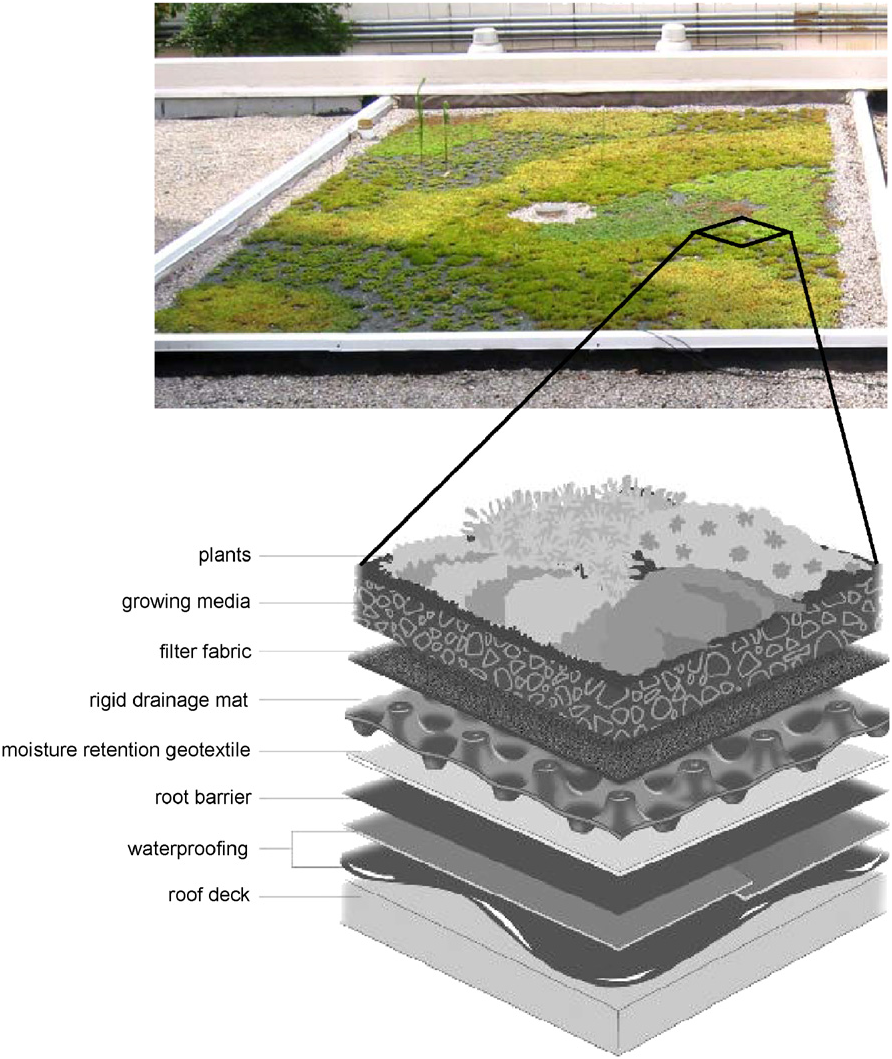7. Rain Barrels | 8. Green Roofs | 9. Detention Ponds
Green Roofs
 |
| Schematic of Green Roof. |
| Image from Carter and Keeler, 2008 |
What is a green roof?
Green Roofs, also known as "vegetated roofs" or "ecoroofs," reduce the effects of urban stormwater by turning impervious rooftops into water-absorbing green space.
Why green roofs?
A large percentage of urban land is covered by impervious surfaces such as roads, parking lots, and rooftops. These surfaces prevent rainwater from infiltrating into the ground, causing it to accumulate quickly on the surface. Since most of these urban land parcels do not have green space available for infiltration, there is a need to create it. One way to do this is to remove the buildings and pavement that cause the problem. This is not always practical, so the alternative is to generate green space on the roof tops by installing Green Roofs.
How do they manage stormwater?
The vegetation of the Green Roof helps to mitigate storm water problems in a number of ways. Rain water falls on the vegetation and begins to seep into the growing media. As small air pockets between soil particles fill with water, the green roof acts like a sponge and soaks up as much rain as it can hold.
This mitigates the problems of urban stormwater runoff in two primary ways. The first is through attenuation: which is the lowering of peak run off volumes during a rain event. Some of the water that has been absorbed into the soil sponge is taken up by the plants, and released back into the air through plant transpiration. Also, with the help of wind and dry air, some of the stored water evaporates directly from the soil. Both these effects help to reduce the total volume of rain water which enters the storm sewer system.
The second way is by delaying the peak run off from entering the sewer system until after the water which is fallen on the hard surfaces, reducing peak runoff rates. Both the attenuation and delay of stormwater surges helps to prevent urban floods and naturalizes the hydrologic cycle.
Are there any other benefits to having green roofs?
Green roofs provide the community and property owner with benefits other than stormwater mitigation. The most apparent of the community benefits is the aesthetic value they add to the traditionally cold, gray urban landscape. Also, the community will witness a decrease in air pollution and increase in wildlife habitat. The vegetation and microorganisms present in the soil could reduce the TSS and excessive nutrients in the stormwater. However, if fertilizers are used to keep the plants healthy, then the green roof could serve to increase organic nutrient concentration in the storm water.
Benefits to the property owner include the reduction of heating and cooling costs provided by the thermal insulation of the vegetation, as well as a decrease in noise pollution.
Are there any constraints / design considerations?
A huge factor limiting the installation of green roofs is the cost. A professional database has the cost listed between $14 and $40 per square foot. Additionally, some roofs may not have been designed to support the additional load caused by the soil, absorbed water, and vegetation. This fact makes green roofs more practical for new development rather than retrofitting.
There are a number of design considerations that will affect the efficiency of green roofs. Some of these include soil type and thickness, vegetative species and cover, as well as roof geometry (area, dimension and slope), and roof orientation.





